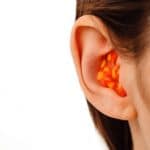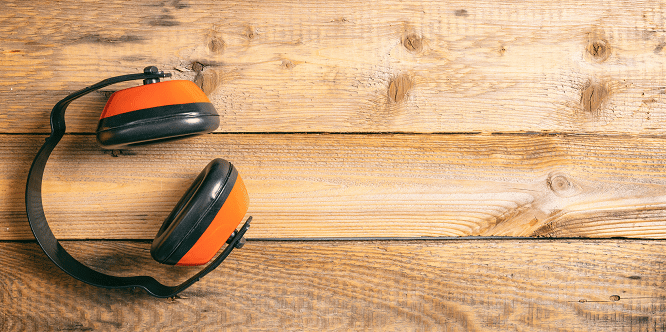KEY TAKEAWAYS: Hearing protection involves many variables, from preferences to the type of work your organization does — here’s what you need to know for your team’s health and wellbeing.
Jump Ahead
According to recent Statistics Canada research, an estimated 11 million Canadians (43% of the workforce) have worked in noisy environments. Over six million (56%) were considered to be vulnerable to noise because they were not required to use hearing protection devices and rarely or never did so. These workers were more likely than other workers to report conditions such as tinnitus and other hearing difficulties.
Workplace noise does not just cause potentially permanent hearing loss. It can also contribute to stress, elevated blood pressure (hypertension), cardiovascular disease, sleep disturbance or sleep disorders, hearing loss, and a higher incidence of workplace accidents. However, hearing loss and the other effects of workplace noise are 100% preventable. According to the Canadian Centre for Occupational Health and Safety (CCOHS), if noise levels rise above 85 decibels, you should be wearing hearing protection. Many jurisdictions require this protection. Here is what you should consider when choosing the right hearing protection.
The Three Main Styles Available
Hearing protection comes in three very different styles. Earplugs are made of a pliable material and are inserted directly into the ear. They are available in disposable, reusable and even custom formats. Semi-insert earplugs are earplugs that are held in place by a rigid headband. Earmuffs, sometimes referred to as ear defenders, are made of sound-attenuating material and have soft ear cushions that fit around the ear surrounded by a hard outer shell. An adjustable headband holds them in place. Ultimately, many workers have different preferences based on the type of work they’re doing, or what they personally find the most effective — that’s something you’ll likely want to take into consideration.
Comfort is key
Hearing protection can’t help if you don’t use it, and you won’t want to use it if it isn’t comfortable. It should fit tightly, but the pressure produced by the fit of earplugs and earmuffs shouldn’t be unbearable. The material they’re made from and how they fit inside the ear canal can both lead to pressure and discomfort with earplugs. The headband portion of earmuffs can also fit too tightly to the head. Ensure your employees have hearing protection that fits comfortably.
Size is also critical to comfort, particularly with earplugs. Smaller sizes are available for people with smaller ear canals who find the standard size uncomfortable. Earmuffs that are too tight can irritate and possibly lead to headaches. Heavier earmuffs can often be more effective in protecting your hearing, but weight can also affect comfort, especially for employees who have active jobs and are moving around a lot with the hearing protection on. Banded ear protectors are lighter and may be more comfortable, but may not provide the right fit you need.
Try a variety of ear protection options and test for proper fit and comfort — there’s no one-size-fits-all solution, and it may take a while to figure out what the right solutions for your organization are.
Proper Fit Is Crucial

Ear protection has to fit well to work. Earmuffs that are too large can slip and allow noise in and cause damage to your ears. The same is true for earplugs. They should fit snugly in the ear to prevent noises from getting past them and into your ear. Audiologists and other trained professionals can also perform fit testing on your hearing protection. This testing can determine personal attenuation or noise reduction ratings for the device in your unique situation and identify issues or problems with existing protections.
Other personal protective equipment (PPE), including safety goggles or helmets, can also affect the fit, and the effectiveness, of hearing protection devices, so these should be considered as well.
Take the nature of the job into account
If work takes place in a hot and humid environment, earmuffs may be uncomfortable, and your employees may be tempted to remove them for occasional relief. This can negate the effectiveness of ear protection. In work environments where acoustic warning signals are essential, you may want to avoid protection that cancels these out or ensure alternatives such as warning lights are available for the safety of your team. In a confined space, larger earmuffs may be a problem, so you may want to choose a smaller or flatter model. These are all things to consider when determining what the right options for your team are.
The noise level in your environment should determine how strong your hearing protection is, but the nature of the noise is also essential. For example, if noise is intermittent, earmuffs might be a better choice as it can be ineffective and inconvenient to insert and remove earplugs as the noise level changes.
Consider Noise Reduction Rating (NRR) and Single Number Rating (SNR) values
Noise Reduction Ratings (NRR) represent a calculation that audiologists and others use to place a value on the reduction in sound pressure levels on the ear with hearing protection. In other words, this value represents how effective your hearing protection is at reducing noise or cancelling out a specific number of decibels.
For example, if you are exposed to a noise level of 100 decibels and your earmuffs cancel out 60 decibels, you will only be exposed to 30 decibels of noise.
However, the NRR is a lab-created value, so to properly calculate the value for real-life work experiences, the Ministry of Labour recommends reducing the NRR rating by:
- 70% (0.7) for earmuffs
- 50% (0.5) for earplugs
Your hearing protection should always have an NRR value, so look for it when choosing your hearing protection. Similarly, a Single Number Rating (SNR) assigns a number value to hearing protection that you then deduct from the decibels you will be exposed to. It, too, is a lab-created value.
Get some help from the CSA Rating System
The Canadian Safety Association (CSA) produced a letter system that designates A, B, or C to a device depending on the range of noise reduction it provides. For example, for noise below 90 decibels, you can choose a C device. With 91-95 decibels, you should opt for B and 96-105 decibels, you should select an A level device. If noises reach over 105 decibels, you should be wearing dual devices to protect your hearing adequately. This can help make the process of finding the appropriate level of protection a bit more straightforward for employers.

Ensure your employees are protected
Choosing the proper hearing protection is a decision that incorporates many variables. Balance protection with comfort to ensure the hearing protection chosen will protect your employees. You may also want to consider baseline audiometric testing to make more informed decisions about the hearing protection options you choose for your workforce. Periodic audiometric testing can help you confirm that there is no hearing deterioration detected amongst your employees — and if there is, it will help flag areas or issues you may need to address.
You May Also Be Interested In…
- Do You Have Reasonable Suspicion?
 Employers cannot initiate reasonable suspicion testing without first going through the 5-step process. Reasonable suspicion training provides critical information about how to initiate reasonable suspicion testing, including the 5-step process and other tools that employers can use to help manage the misuse of alcohol and drugs in the workplace.
Employers cannot initiate reasonable suspicion testing without first going through the 5-step process. Reasonable suspicion training provides critical information about how to initiate reasonable suspicion testing, including the 5-step process and other tools that employers can use to help manage the misuse of alcohol and drugs in the workplace. - An Employer’s Guide: What You and Your Employees Need to Know About DOT Drug & Alcohol Testing
 When implementing or maintaining DOT Drug & Alcohol testing, there are key areas that employers should consider.
When implementing or maintaining DOT Drug & Alcohol testing, there are key areas that employers should consider. - SureHire Occupational Testing Acquires COHR Health: A Positive Step Towards Safe, Healthy, Productive Workforces and Communities
 We are thrilled to announce that today, May 6, 2024, SureHire Occupational Testing has officially acquired COHR Health, a well-known leader in occupational health services. Read on…
We are thrilled to announce that today, May 6, 2024, SureHire Occupational Testing has officially acquired COHR Health, a well-known leader in occupational health services. Read on… - Occupational Testing Use Case – Mining
 In this case study, we will explore how mining companies can use various types of occupational tests to reduce Total Recordable Incident Rates (TRIR) long term.
In this case study, we will explore how mining companies can use various types of occupational tests to reduce Total Recordable Incident Rates (TRIR) long term. - 9 Strategies to Keep Workers Cool on Drilling Sites During Hot Summer Months
 This article delves into strategies to keep workers cool and safe on drilling sites during the hot summer months.
This article delves into strategies to keep workers cool and safe on drilling sites during the hot summer months. - Hearing Conservation Basics: How to Manage Occupational Noise
 Learn how to proactively mitigate occupational noise risks and help prevent NIHL among workers.
Learn how to proactively mitigate occupational noise risks and help prevent NIHL among workers.

